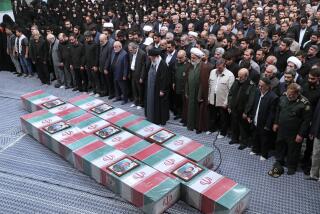Pentagon adjusts plans for more intense attacks on Syria
- Share via
WASHINGTON — The Pentagon is preparing for a longer bombardment of Syria than it originally had planned, with a heavy barrage of missile strikes followed soon after by more attacks on targets that the opening salvos missed or failed to destroy, officials said.
The planning for intense attacks over a three-day period reflects the growing belief in the White House and the Pentagon that the United States needs more firepower to inflict even minimal damage on Syrian President Bashar Assad’s forces, which have been widely dispersed over the last two weeks, the officials said.
Two U.S. officers said the White House asked for an expanded target list in recent days to include many more than the 50 or so targets on the initial list. As a result, Pentagon planners are weighing whether to use Air Force bombers, in addition to five warships now on patrol in the eastern Mediterranean Sea, to launch cruise missiles and air-to-surface missiles from hundreds of miles offshore, well out of range of Syrian air defenses.
Syria is also within range of an aircraft carrier strike group in the Red Sea, which includes one cruiser and three destroyers, all capable of firing cruise missiles.
“There will be several volleys and an assessment after each volley, but all within 72 hours and a clear indication when we are done,” said one officer familiar with the planning.
The officers requested anonymity because they were not authorized to publicly discuss the campaign.
The stepped-up military planning comes as President Obama and his aides prepared to press their own offensive to seek public support, as well as congressional votes for authorization to use military force to punish Assad’s government for alleged use of chemical weapons against civilians last month.
Obama plans to blanket the nation’s airwaves in coming days to make his case to a skeptical public. Aides say he will tape interviews Monday with the anchors of CBS, NBC and ABC, the three major broadcast networks, as well as with PBS, CNN and Fox News. He also will address the nation from the Oval Office on Tuesday, the night before the full Senate is expected to vote.
Obama, who has declined to say whether he would order an attack if Congress votes against it, gave a preview of his argument in his weekly radio address Saturday.
“Failing to respond to this outrageous attack would increase the risk that chemical weapons could be used again, that they would fall into the hands of terrorists who might use them against us, and it would send a horrible signal to other nations that there would be no consequences for their use of these weapons,” he said.
The administration ran into a new diplomatic roadblock Saturday at the European Union.
Foreign ministers of the EU’s 28 member nations, meeting in Vilnius, Lithuania, said that “the international community cannot remain idle” after reports that poison gas was used Aug. 21 against neighborhoods near Damascus held by rebels trying to topple Assad.
But despite the presence of U.S. Secretary of State John F. Kerry, the EU declined to back a military strike without approval of such intervention by the United Nations. American officials say they see almost no chance of winning a resolution for use of force in the U.N. Security Council because Russia, a permanent member with veto power, is Assad’s strongest international backer.
The EU ministers noted that U.N. chemical weapons inspectors were expected to report on their findings in Syria. They also welcomed a decision by French President Francois Hollande, a vocal advocate of a military strike, to wait for the inspectors’ report before taking further action.
Obama still favors a limited attack that would not involve sending large numbers of warplanes over Syria to drop bombs, officials said.
But some military officers are doubtful that even a longer air campaign, using cruise missiles fired from offshore, will hurt Assad enough to degrade his forces and to deter future use of chemical weapons. One officer described the planned operation as little more than a multi-day “show of force,” not a game-changer in Syria’s bitter civil war.
The planned U.S. attack “will not strategically impact the current situation in the war, which the Syrians have well in hand, though fighting could go on for another two years,” said another U.S. officer familiar with the latest intelligence estimates.
The Obama administration hopes that by denying Assad the option of resorting to chemical weapons and by providing some additional weapons and training to rebel fighters, it will boost the now remote chances of negotiations that might lead to Assad’s exit.
The administration has struggled over the last week with the competing demands of hitting Syria hard enough to undermine Assad’s resolve but not hard enough to undermine support by members of Congress who are leery of being drawn into another Middle East war. A smaller contingent has urged Obama to provide more muscular support for the rebels seeking to oust Assad.
Facing such cross-currents, administration officials and top Pentagon officers have veered between describing the planned attack as a limited operation that will not significantly tilt the balance of power in Syria and a punishing attack that will degrade the Syrian military’s equipment and forces capable of delivering chemical weapons and deter Assad from using them.
The current planning tries to thread the needle. After the initial round of strikes, the Pentagon will assess the damage inflicted on Syrian forces using satellite imagery and other surveillance systems. The U.S. military then can either hit targets that weren’t destroyed or choose new ones to ensure that Assad suffers significant losses, current and former military officers said.
“It’s got to lead to something or we’re going to be back in the same situation a year from now,” said Mark Kimmitt, a retired Army brigadier general and former top Middle East planner who served as a Pentagon and State Department official during the George W. Bush administration. “So we’ve got to have a larger target set.”
Pentagon planners also are offering options to hit Assad again if he or his regional proxies retaliate against the United States or its allies, the two officers said.
Administration officials have signaled that they intend to move ahead with their plans to provide arms to some Syrian rebel factions, a demand by Sen. John McCain of Arizona and other Republicans who have called for aiding the rebels in return for their supporting any resolution to authorize force.
In closed-door briefings with lawmakers last week, the administration said Assad’s conventional forces were concentrated around Damascus, the capital, and in the north of Syria. But many installations and pieces of equipment, including rocket launchers, tanks and other hardware, have been moved in the last two weeks to avoid as much as possible the expected U.S. attack.
Gen. Martin Dempsey, chairman of the Joint Chiefs of Staff, acknowledged during two days of congressional testimony the possibility of follow-up strikes. He said the Syrian military was moving forces, making more difficult the task of striking units and equipment capable of delivering chemical agents.
“At this point our intelligence is keeping up with that movement,” Dempsey said. He also noted reports that prisoners and other noncombatants had been moved to potential military targets where the U.S. might strike.
Times staff writer Henry Chu in London contributed to this report.
More to Read
Sign up for Essential California
The most important California stories and recommendations in your inbox every morning.
You may occasionally receive promotional content from the Los Angeles Times.











